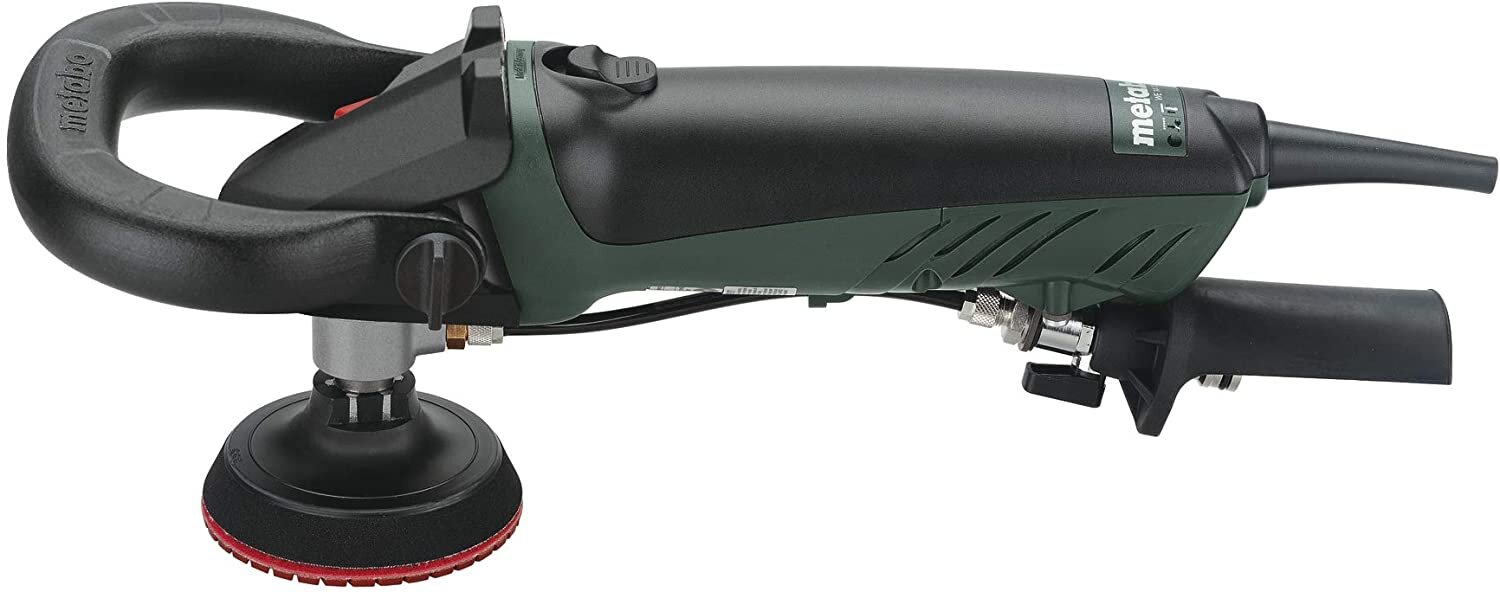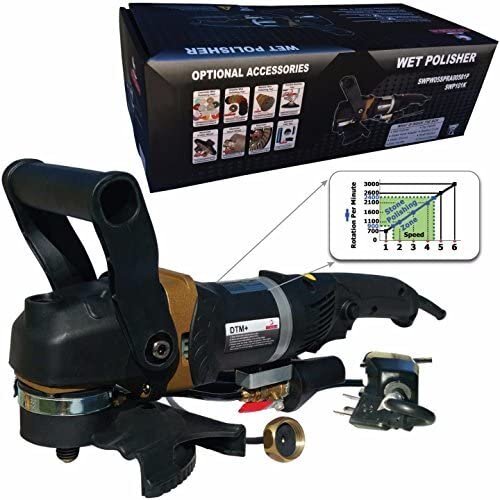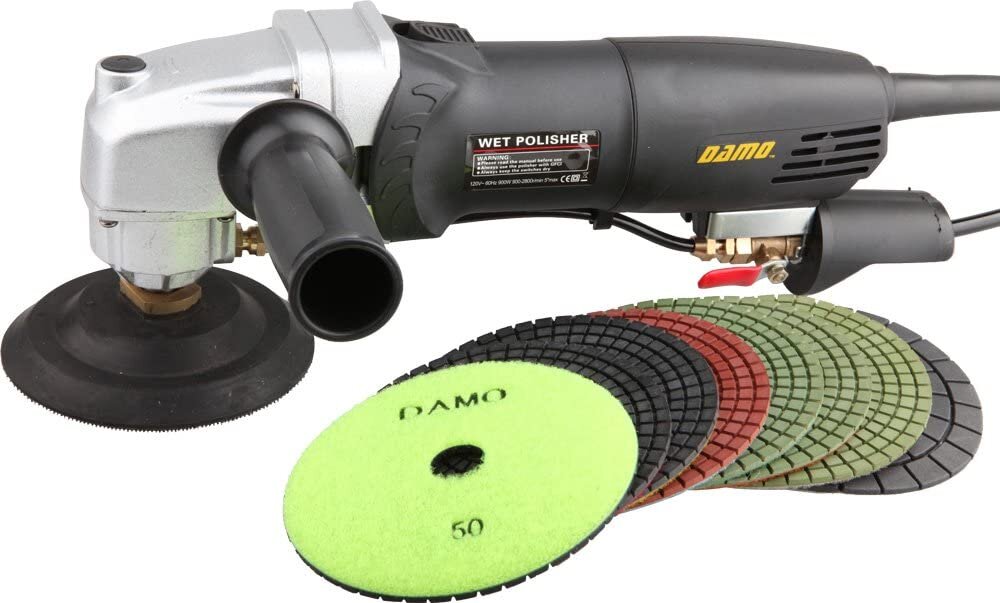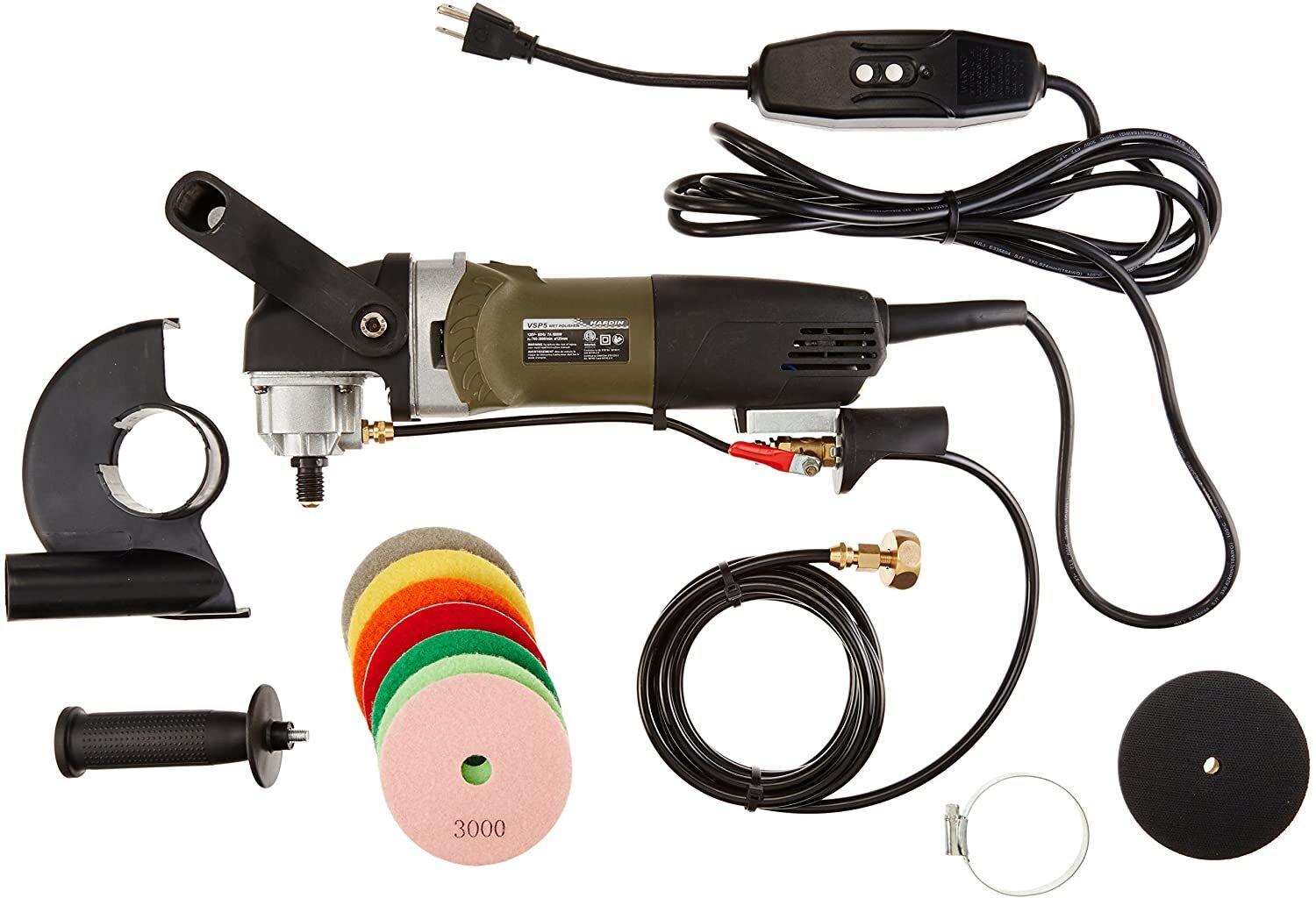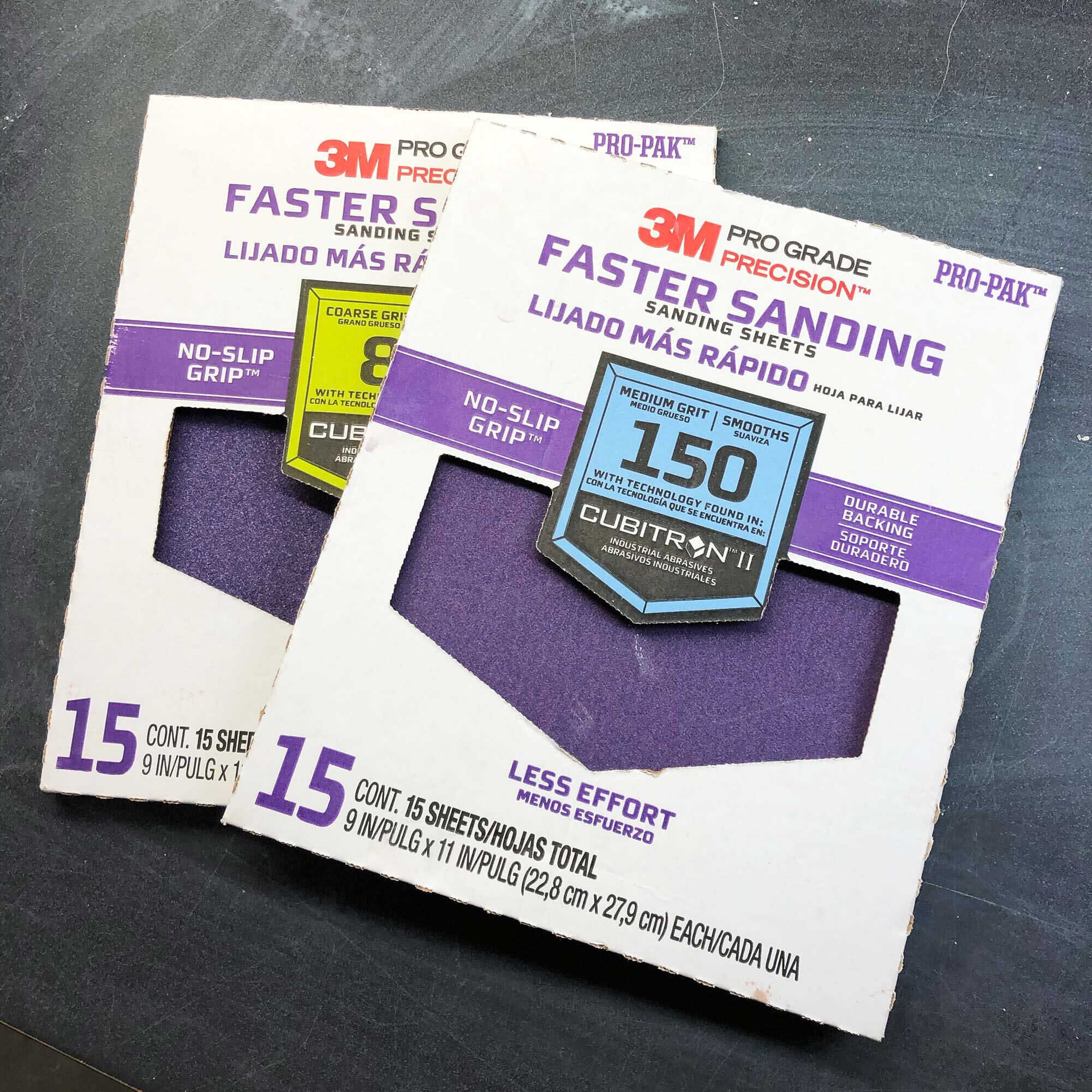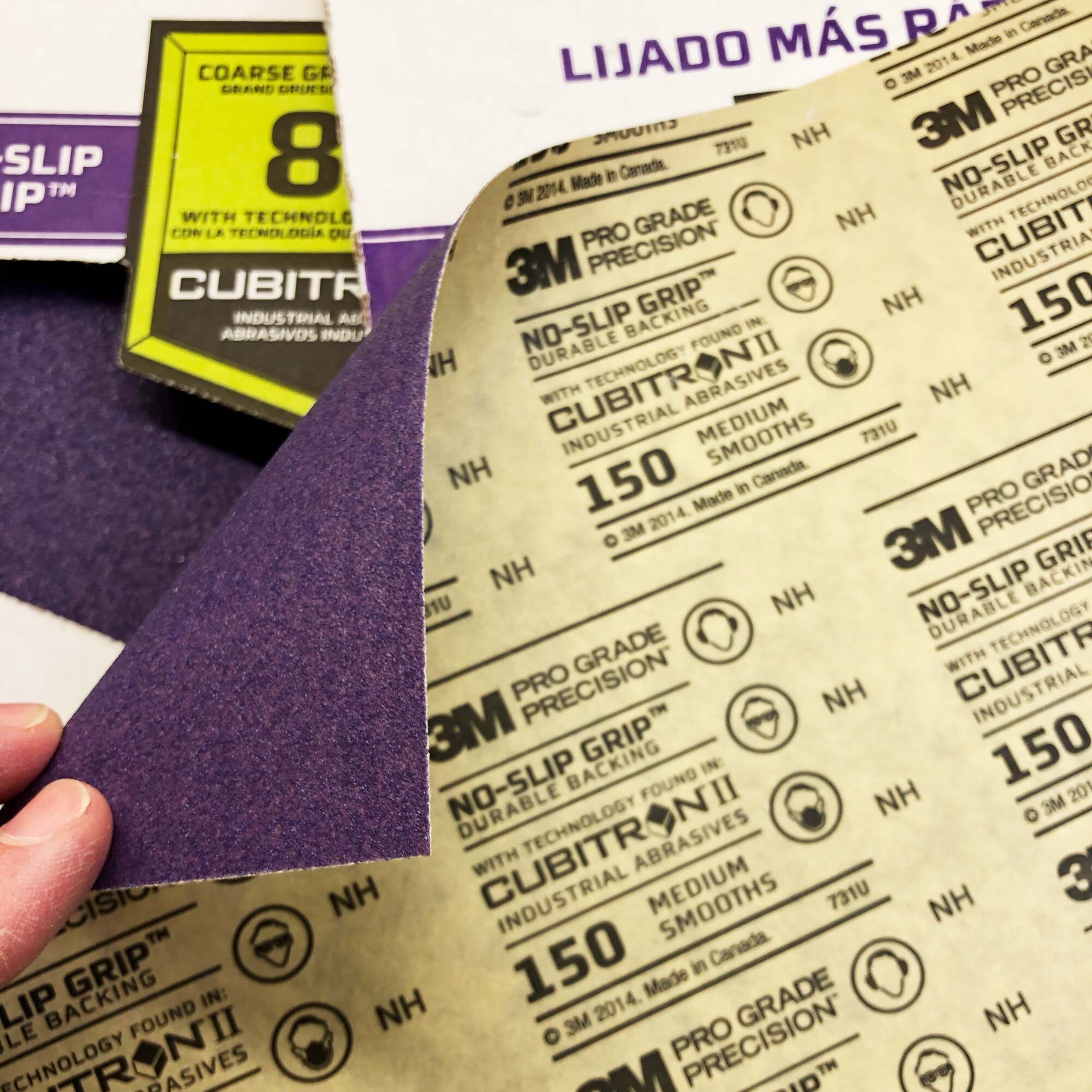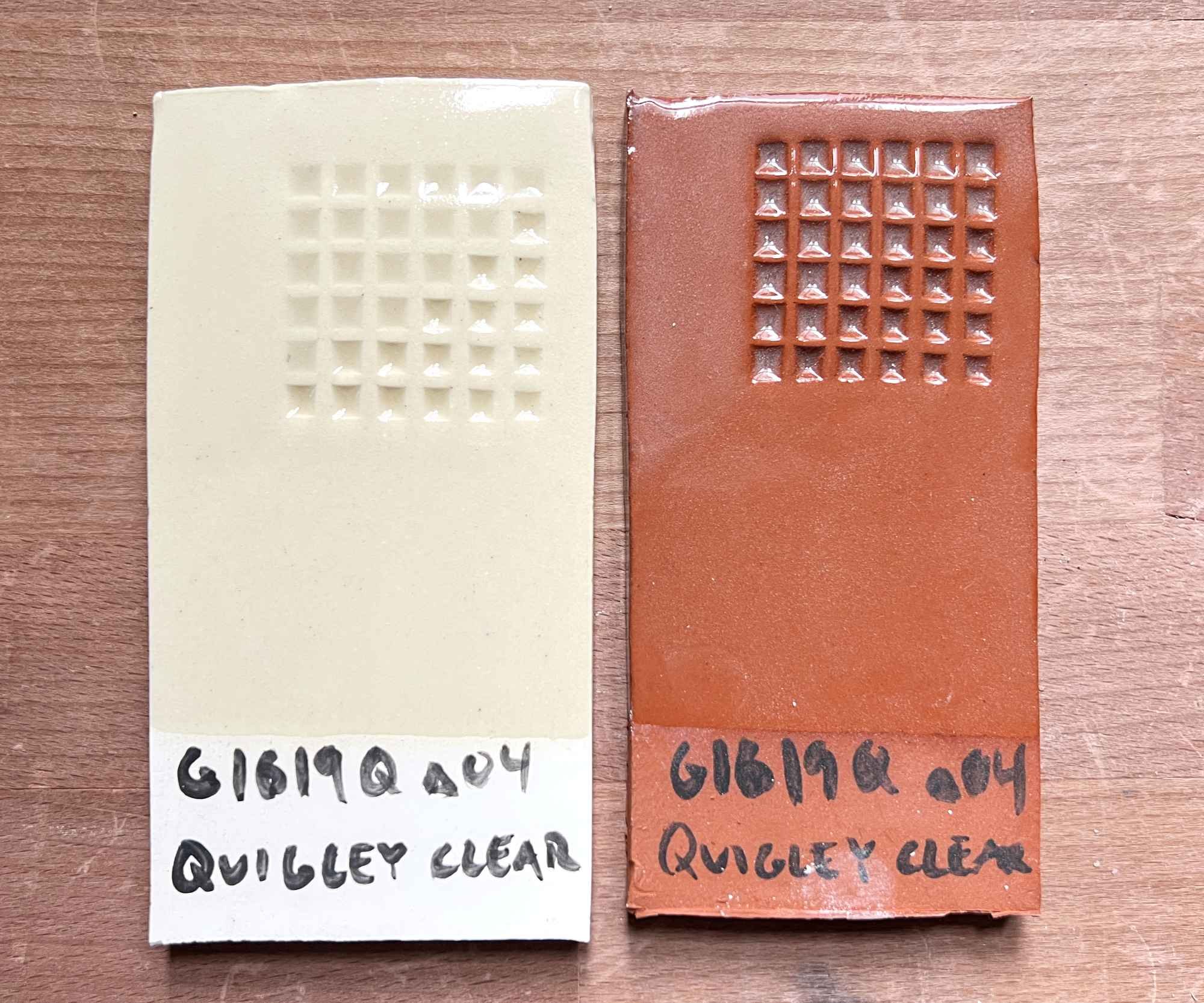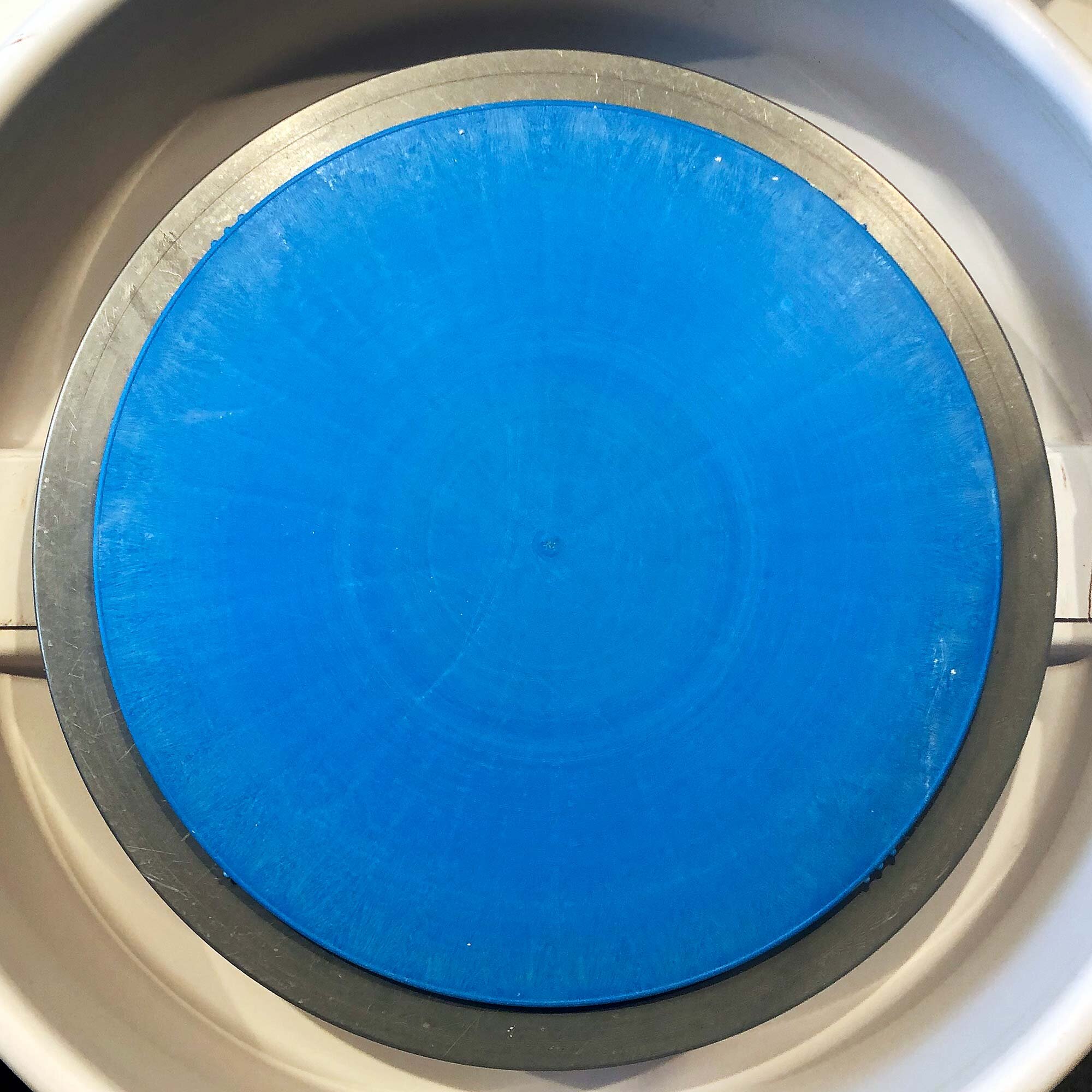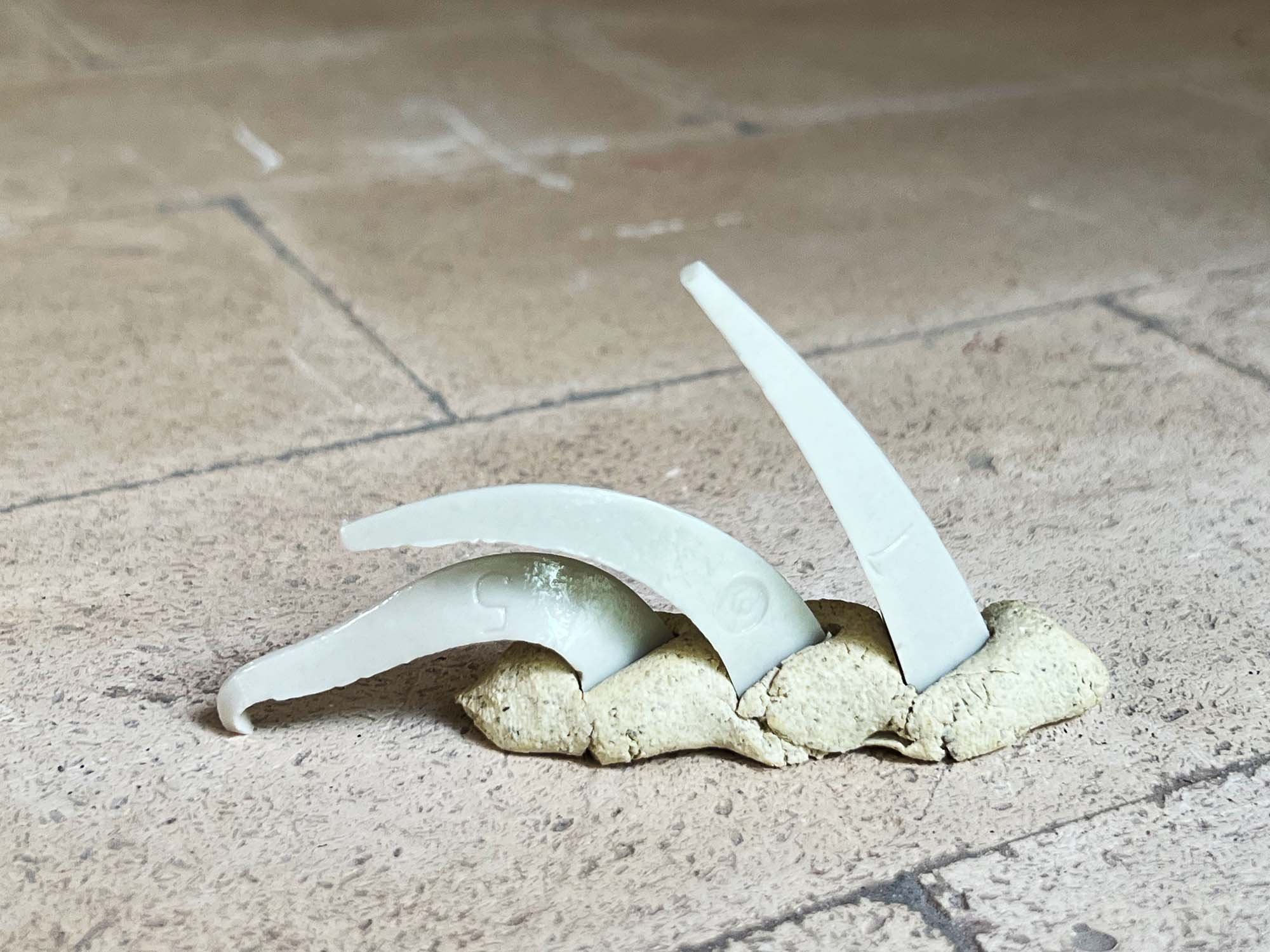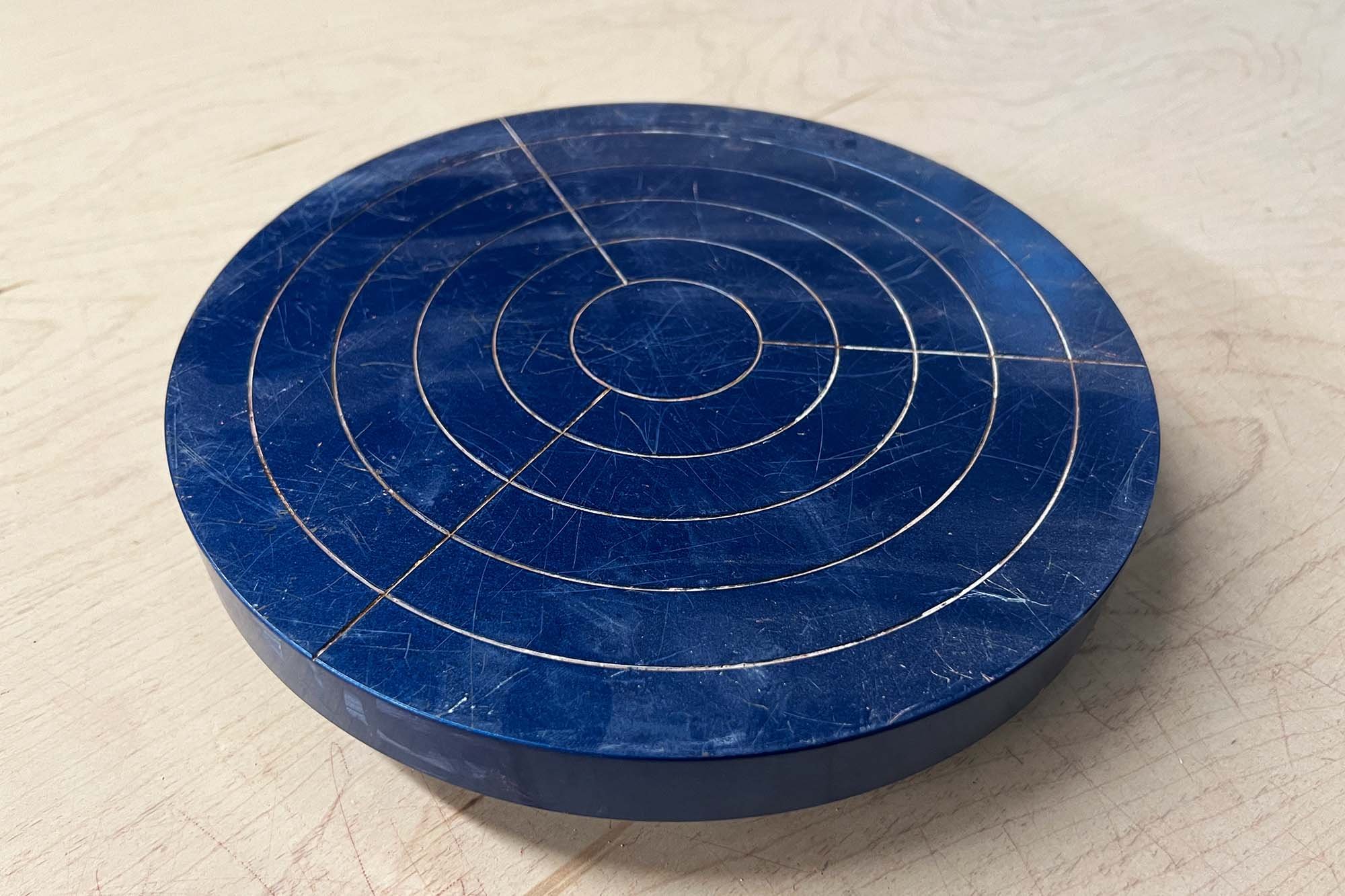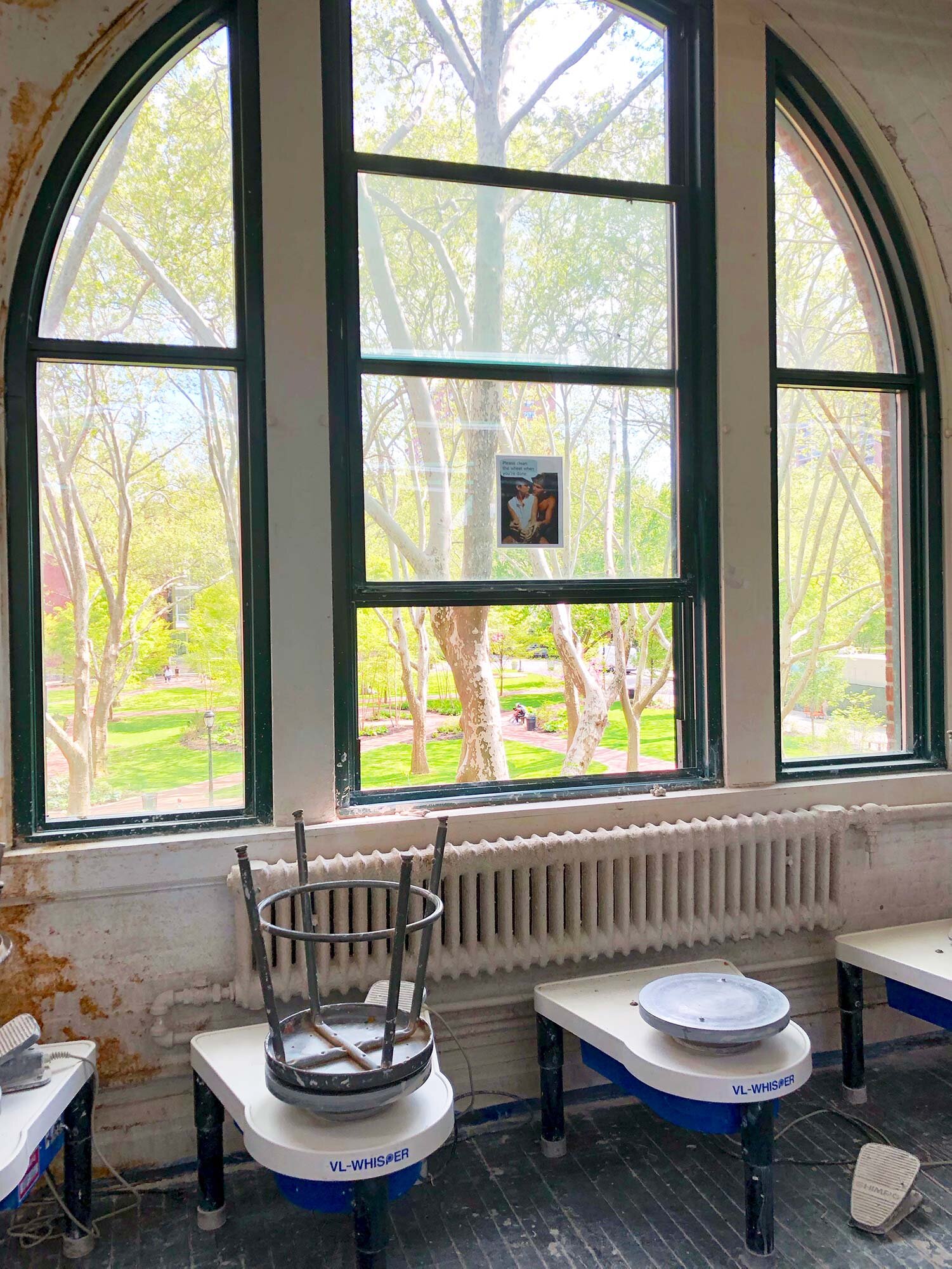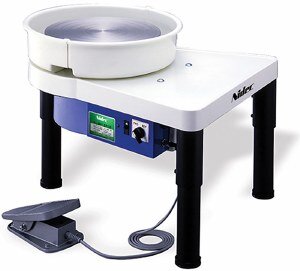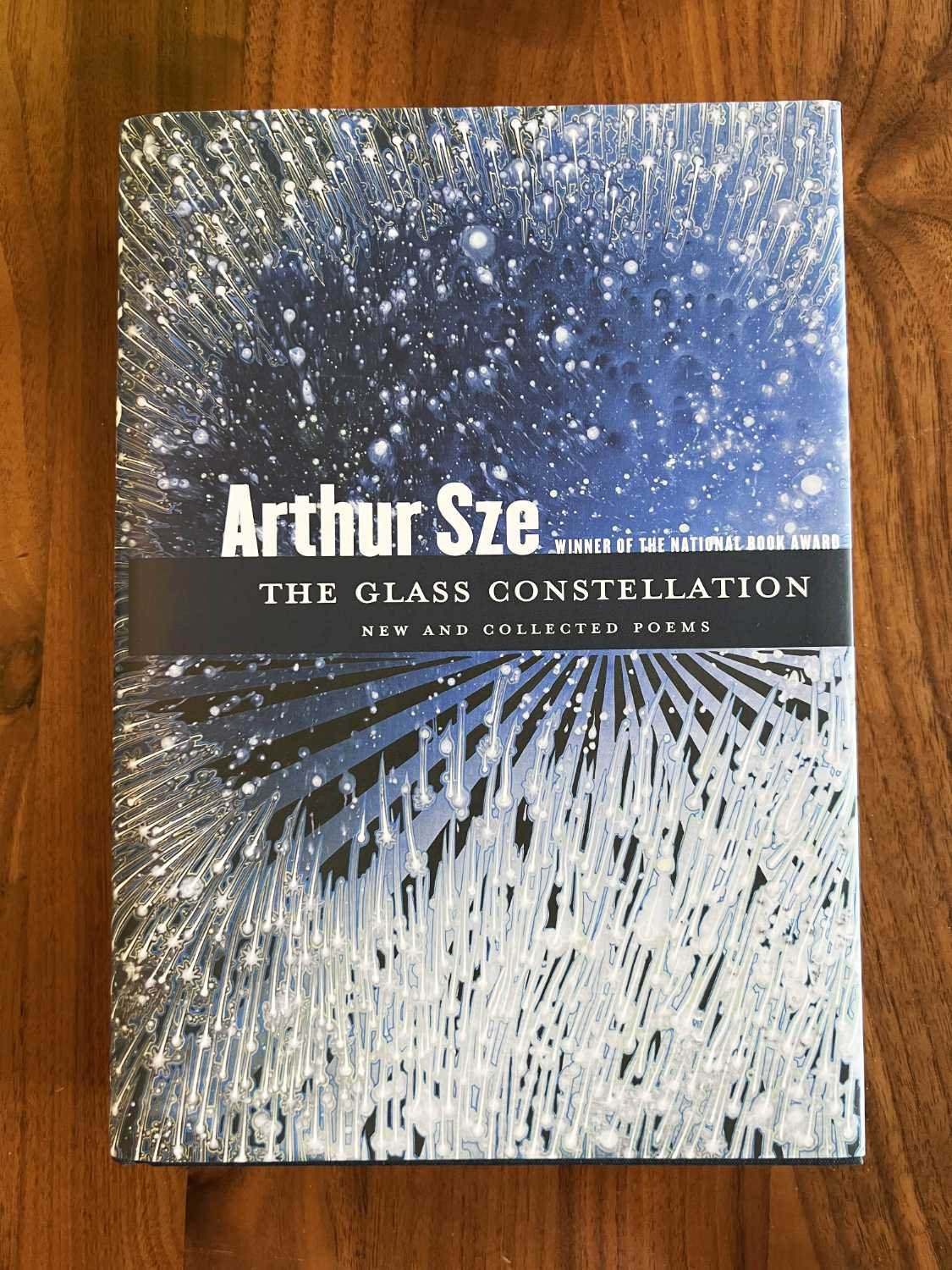There are a variety of wet polishers/grinders on the market, but models from Flex, Makita, and Metabo are clear market leaders. These are long-lasting, professional-grade tools that will hold up under heavy use for all your grinding and polishing needs. There are other options, but the top three picks are clearly superior to various generics and off-brand models. These tools are mostly designed for polishing and routing marble and stone, but they work great with ceramic, glaze, concrete and other materials.
A complete review and guide to wet polishers is below, but first:
TOP PICK: Flex LE 12-3 100 Variable Speed Wet Polisher / Grinder
The Flex LE 12-3 100 Variable Speed Wet Polisher / Grinder.
The top pick (and the model I use in the studio) is the Flex LE 12-3 100 Variable Speed Wet Polisher / Grinder.
The Flex polisher has a 9.3 amp motor with speeds ranging from 1200 to 3700 RPM, can accommodate up to 5 inch pads, weighs 5.5 lbs (2.4kg), and it is made with high-quality rubber hoses and cords that stand the test of time. One distributor reports that of all the wet grinder models, this gets returned the least, speaking to its quality. The Flex Variable Speed Wet Polisher typically retails for around $320-$340.
Like most power tools, you do have to pay for quality with wet polishers. The top three models from Flex, Makita and Metabo are among the most expensive models, generally costing between $300 and $350 plus extra for a pad and grinding discs. But for an electric tool used in such close proximity to water, you definitely want a tool that you can trust.
Is this a necessary tool for everyone? Most likely not. A wet polisher/grinder is a specialized piece of equipment. But once you have one, you’ll find lots of uses ranging from clean up and polishing, to opening up new decorative possibilities with ceramic glazes. And it’s always great to have a water-based sanding operation to keep dust down in your studio.
SAFETY NOTE
Wet polishers / grinders have electrical motors and a water feed. Use proper safety equipment including eye protection, rubber gloves, and possibly a rubber apron. These machines will cast water in many directions, so create a protected area and endeavor to keep water away from the motor and electrical cords. If you feel a “tingle” of electricity, cease use and assess what is causing the problem. All of these tools come with a built-in Ground Fault Circuit Interrupter (GFCI) and if possible, you should plug them into an outlet that also has a GFCI. If the on-unit GFCI is not working, do not use the tool.
Table of Contents
Top Pick: Flex LE 12-3 100 Variable Speed Wet Polisher / Grinder
2nd Top Pick: Metabo PWE 11-100 Variable Wet Polisher / Grinder
3rd Top Pick: Makita PW5001C Variable Speed Stone Polisher
Runner Up: Stadea SWP 101K Wet Polisher
Other options
Comparison Chart / Buyer’s Guide
How To Use A Wet Polisher
Summary
Top Pick: Flex LE 12-3 100 Variable Speed Wet Polisher and Grinder
The Flex Wet Polisher / Grinder with a 4 inch pad attached, and showing 4 and 5 inch Stadea brand diamond grinding pads.
The Flex LE 12-3 100 is the top pick because of its many high-quality features including variable speed, ability to accommodate up to 5” pads, quality of construction including a rubber hose that won’t get kinks, and durability. It’s a close race with the Makita and Metabo models, but this German-made machine stands out for it’s overall quality and ease of use. I’m happy to report that this is the machine I have been using in my studio and it has held up under 6 years of frequent use. If I was shopping today, I would look most closely at this model and the Metabo.
The Flex comes with a 1 year warranty, and has a 9.3 amp motor with speeds ranging from 1200 to 3700 RPM. It does not come with an adapter for the quick-release hose, so you will have to find something that works for your studio. I use a simple garden hose to quick-release connector and I’ve also found attachments to get the hose connector fitted on a faucet.
Flex also makes a single speed model that costs about $20 less, but I think a variable speed wet polisher is the way to go. I typically use speeds ranging from 2 to 4 on this, or 1700 to 2400 RPMs. The speed adjuster is a dial on the back of the tool (see pictures below).
If you read online reviews, the only drawbacks that users report is difficulty finding the right hose connector (I found it easy to find however) and some report GFCI issues. I am very careful when using a wet polisher, and can say I’ve never felt one tingle or shock from this machine.









Slideshow of more images of the Flex LE 12-3 100 Wet Polisher.
2nd Top Pick: Metabo PWE 11-100 Wet Polisher / Grinder
The Metabo PWE 11-100 Wet Polisher, pictured here with a 4 inch pad.
The Metabo PWE 11-100 another variable speed, German-made wet polisher / grinder that has a lot of great features and is one of 3 professional-grade wet polishers that are best for ceramic and sculpture studios. It has a 9.6 amp motor with speeds ranging from 1700 to 6100 RPM, can accommodate up to a 5 inch pad. It also has an adjustable handle and a standard 1 year warranty with can be extended to 3 years with online registration.
Note the conveniently placed water switch near the rear hand grip on the Metabo.
This is the most recent wet polisher to the market, and Metabo has looked hard at the Flex and Makita models to try to find innovative touches, namely the extra speed, adjustable handle, and best of all, placing the water switch near the rear grip so you can cut the water with a push of your finger.
Some online users report issues with finding a quick connect adapter that works, but I think if you just take your grinder to the hardware store, you should be able to find something that works. All in all, this is a great model that goes head to head with the Flex. I’m really happy with my Flex Wet Polisher but I’d look really close at this model if I was buying a new machine today.
3rd Top Pick: Makita PW5001C 4” Wet Polisher / Grinder
The Makita PW5001C Wet Polisher
The Makita PW5001C Wet Polisher is one of the most popular wet grinders on the market and you will find extensive reviews and feedback, which speaks to its overall quality and professional-grade durability. It has a 7.9 amp motor with speeds ranging from 2000 to 4000 RPM, and can accommodate up to a 4” pad.
This model was the first to feature a water feed on the bottom of the machine, which was an innovation soon copied by Flex and Metabo. It has a 1 year warranty. It also has a traditional side grip front handle, similar to what you see on angle grinders.
Some reviews once again found issues with getting the correct attachments for the quick-release hose, but I’m sure a well-stocked hardware store will have something that will get this machine working in your studio.
Overall, it’s a great tool but has a few drawbacks in comparison to the Flex and Metabo including a weaker motor, smaller speed range, and is only recommended up to a 4 inch pad. In general, I mostly use 4 inch pads but I like to have the option for a bigger pad for polishing flat surfaces. But if the Makita seems right for you, don’t let the pad size be the deciding factor. This is the best-selling wet polisher for a reason and Makita is trusted by many professionals in the stone polishing business.
Runner Up: Stadea SWP101K Wet Polisher
The Stadea 101K Wet Polisher / Grinder.
Outside of the top three professional-grade wet polishers, the Stadea 101K is the best of the budget models. It has a variable speed motor with a range of 700 to 3000 RPM, a splash guard, and can accommodate up to a 5 inch pad. At 9 pounds, it does weigh significantly more than top 3 models, which all weigh about 5 to 5.5 lbs.
The Stadea wet polisher comes with a 6 month warranty and is available as a standalone tool for $200 or can be purchased in packages that include a pad and grinding discs for around $300. Stadea pads are a great option for diamond polishing pads and what I use in the studio, so that package might be an attractive purchase.
Stadea also sells packages, such as this kit with a 4 inch pad, 7 diamond grinding discs, and a buffing pad.
Users report a variety of problems with this model (and every other budget model) including water leaks and issues with feeling a tingle of electricity while using. It seems that some of these problems may stem from improper use or setting up a workspace incorrectly, so just be careful and you should be fine. But the issue with cheap washers or improper fit of the built-in garden hose connector are annoying and speak to the drawbacks of shopping budget-grade models. If they shortchange the hose connector, what else might be a problem?
Other Models and Options
The six models described below are very affordable but have lots of mixed reviews online. Some users report that these worked great for them, others point to issues with build-quality, overheating, motors dying, and other issues. They also have short warranties or none at all, so shop at your own risk! Many of these models have very similar looking parts, such as the switch on the water valve, and the brass garden hose attachment.
The Damo 4” Wet Polisher Kit
Damo Variable Speed Wet Polisher
The Damo variable speed wet polisher has a 7 amp motor with speeds ranging from 700 to 3000 RPM and is available as a polisher for $180 or as a kit for around $220 to $240. It has a side handle, a bottom water feed with a switch near the rear of the tool, and can accommodate up to 5 inch pads. Overall, many online reviewers were happy with this tool although it’s weight (6.5 lbs) was reported as a drawback. A decent number of reviewers also mentioned that the tool stopped working or had broken parts after a month or two of use. If you’ll occasionally need a wet polisher, this might work, but it’s most likely not going to hold up for months or years under heavy use.
The Hardin WV 4” Wet Polisher Kit
Hardin WV Polisher
The Hardin WV Polisher features an 8 amp motor with speeds ranging from 1000 to 4000 RPM and comes in a kit with a 4 inch backer and set of diamond polishing pads. It has a top water feed with a shutoff valve by the front handle, and comes with a hose and garden-hose attachment.
It has a 90 day warranty and extremely mixed reviews, including a few that mentioned the onboard GFCI didn’t trip even when exposed to water. Yikes! It’s available for the ultra-budget price of $107.
Hardin HWV Wet Polisher
The Hardin HWV Wet Polisher has an 800 watt motor with speeds ranging from 700 to 3000 RPM, and is designed to use with 4” pads. I wasn’t able to locate warranty or weight information, but I assume it’s around the same as the Hardin unit listed above. This polisher comes with a backer pad, diamond discs, and a hose attachment that will fit a standard garden hose. It was a bottom water feed, a splash guard, and two handles options.
Like all the budget models, it has extremely mixed reviews with some users saying they loved it while others reported that motor ran extremely hot, and that they had problems with the GFCI. One user reported that extra plastic flashing from the manufacturing process were blocking air vents to the motor, and that cutting those helped reduce the motor overheating issue. Overall, this is a very budget option that costs $140 for the bare tool or around $165 for a kit.
The Hardin HWV Wet Polisher Kit.
The Kawaii WEP 250 Wet Polisher
Kawaii WEP 250
The Kawaii WEP 250 Wet Polisher has variable speeds ranging from 900 to 2800, can accommodate up to 5 inch pads, and has a 90 day warranty. This is a model that is carried at Home Depot so you might be able to see it in person in store. It weighs 6 lbs and has many similar parts to other models here, including the water valve switch and garden hose connector. It doesn’t have a lot of reviews online so it’s hard to get much info, but it seems like a pretty straightforward option. One reviewer compared it to the Metabo and described this as a great budget option but did report feeling a few tingles while using, and that the hose connector had to be taped to reduce leakage. It retails for around $145
QuickT SPW702A Wet Polisher
The QuickT SPW702A Wet Polisher is one of a few models with the “old school” top water line feed, and it has variable speeds ranging from 1000–3000 RPM. It comes with a splash guard, brass hose fitting on the water line, and retails for the budget price of around $150 in a kit that includes pads.
It has a lot of great reviews online, and some who had a few problems. To my eye, it looks very similar to the Hardin WV model with the top water feed. As with many of these budget models, warranty info is not mentioned. It may work for a project or two, or longer if you take care, but it doesn’t come with any sort of manufacturer standing behind it.
ZFE 4” Wet Polisher
The ZFE 4” Wet Polisher is another model with the water feed at the top, a splash guard, and a weight listed at between 8.5 and 9 lbs. To my eye, it looks very similar to the QuickT and Hardin WV models, and it retails for around the same price, $170 with a backer pad and polishing pads. It has a variable speed ranging from 500 to 3000 RPM, and doesn’t have warranty info listed online. It has varied reviews with some reporting great success, and others mentioning problems with the O rings on the water line.
Wet Polisher / Grinder Comparison Chart
This chart is with the top picks first, then other models are listed alphabetically.
Note: All models have built in GFCI and 5/8" arbor for backer pad attachments. Some manufacturers list motor by amp, watts, or both and every effort has been made to locate that info.
| Top Picks | Typical Price | Motor | Max Pad | RPM Range | Weight | Water Feed | Warranty |
|---|---|---|---|---|---|---|---|
| Flex LE 12-3 100 | $320-$340 | 7.9 amp, 1150 watt | 5" | 1200-3700 | 5.3 lbs | Bottom | 1 year |
| Metabo PWE 11-100 | $310-$330 | 9.6 amp, 1100 watt | 5" | 1700-6100 | 4.9 lbs | Bottom | 1 to 3 years |
| Makita PW5001C | $300-$320 | 7.9 amp | 4" | 2000-4000 | 5.1 lbs | Bottom | 1 Year |
| Stadea SWP101K | $198 | 800 watt | 5" | 700-3000 | 9 lbs | Bottom | 6 months |
| Other Models | |||||||
| Damo | $180 | 7 amp, 800 watt | 4" | 700-3000 | 6.5 lbs | Bottom | ? |
| Hardin WV | $108 | 800 watt | 5" | 1000-4000 | 8.8 lbs | Top | 90 days |
| Hardin HWV | $165 | 800 watt | 5" | 700-3000 | ? | Bottom | ? |
| Kawaii WEP 250 | $145 | 7 amp, 900 watt | 5" | 900-2800 | 6 lbs | Bottom | 90 days |
| QuickT SPW702A | $151 | 800 watt | 5" | 1000-3500 | 9 lbs | Top | ? |
| ZFE | $170 | 800 watt | 5" | 500-3000 | 8.7 lbs | Top | ? |
How to Use a Wet Grinder and a Few Tips
Wet Polisher / Grinders are a specialized tool that can really make short work of your polishing jobs. But with that speed comes potential mess if you don’t have the proper set up. A few tips:
Use in a large slop sink or something with walls if possible. This will keep water splashing down.
Be aware of where the polisher might spray water, keep electrical outlets protected
Wear rubber gloves and rubber apron
Use the least amount of water you need.
Clean your tool after use, the sprayed water will contain a lot of grit which can cause problems with switches, dials and other moving parts of your tool.
For ceramic glaze or kiln shelf clean up, I use 50 grit pads first, then 100, 200 and 400. I don’t usually go higher than 400. Rather than get the traditional 50-3000 grit pad set, you may just need 4 pads. I use Stadea pads. Click here to purchase individual pads.
If needed, get multiple backer pads so you can use different size pads. My favorite size is 4” but I do have 5” too.
For a really cool use of this tool, check out what the artist Brad Miller does with his wet polisher. He makes textured forms and then layers multiple colors of pigmented slip and glaze. After the final glaze fire, he will polish back through, revealing the stratified layers.
Summary
Wet Polishers are great tools if you are looking for a dust-free way to grind ceramic, glaze, stone, concrete or other hard surfaces. They will quickly dispense with the biggest glaze drips, getting your piece ready for display. They are also great for cleaning up kiln shelves. There are a variety of models on the market but 3 professional grade models from Flex, Metabo, and Makita really stand out. Not only are these models backed by good warranties, the tools are built to last and survive the test of time. There are also budget options available if you are looking for a tool that will be used just occasionally. The tradeoffs between the professional grade and budget models are clear: fewer hassles, better parts, and tools that will just keep working. The goal of this post was to share my own experience with wet polishers and to give an overview of what is available to buy.



